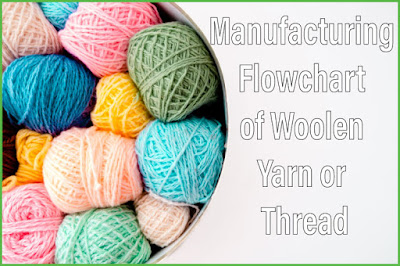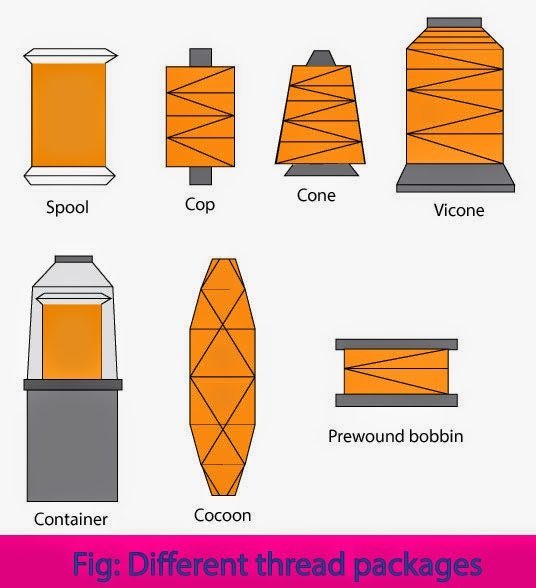Manufacturing Flowchart of Woolen Yarn
Last updated on June 20th, 2023 at 05:41 pm
The simple term “wool”, according to government standards, must always mean new wool that has not been made up in any form of wool product. New wool comes directly from a fleece. It has never been previously spun, woven, felted, or worn.
The term “virgin wool” is now used by the textile industry to designate new wool from a sheep’s fleece, but the term is too all-inclusive to serve as a criterion of quality. Although the term testifies to the fact that virgin wool does not contain recycled wool fibres, it can be used to identify the less desirable fibres of a fleece as well as especially fine quality of wool. Virgin wool may also include pulled or dead wool, which may be of definitely inferior stock. It is important to remember that a high grade of recycled wool makes a more serviceable fabric than one having a low grade of new wool.
Process Flowchart of Woolen Yarn
Preparation
↓
Sorting and Grading
↓
Garneting
↓
Scouring
↓
Drying
↓
Oiling
↓
Dyeing
↓
Blending
↓
Carding
↓
Gilling and Combing
↓
Drawing
↓
Roving
↓
Spinning
Preparation
Fleeces vary from 6 to 18 lbs in weight, average about 8 lbs each. In Australia, the fleece is separated at the time of shearing according to its quality. Superior wool comes from the sides and shoulders, where it grows longer, more delicate, and softer and is treated as one fleece; wool from the head, chest, belly and shanks is treated as a second fleece. Domestic wool reaches the mill in loosely packed bags; imported wool comes in tightly compressed bales. Each fleece contains different grades. The raw stock must be carefully graded and segregated according to the fiber’s length, diameter, and quality.
Sorting and Grading
Wool sorting is done by skilled workers who are experts in distinguishing qualities by touch and sight. As many as twenty separate grades of wool may be obtained from one fleece if the sorting is incredibly rigid. Each step is determined by type, length, fineness, elasticity, and strength.
Garneting
Recycled wool fibres are obtained separately by reducing the unused and used materials to a fibrous mass by a picking and shredding process called garneting.
Scouring
The next step in preparing raw wool for manufacturing is through washing in an alkaline solution; this process is known as scouring.
Drying
Wool is not allowed to become dry. Usually, about 12 to 16 percent of the moisture is left in the wool to condition it for subsequent handling.
Oiling
As wool is unmanageable after scouring, the fibre is usually treated with various oils, including animal, vegetable and mineral.
Dyeing
If the wool is to be dyed in the raw stock, it is dyed at this stage.
Blending
Wool of different grades may be blended or mixed at this point. It is not uncommon for tag locks and inferior qualities of wool to be combined with better grades.
Carding
In the manufacture of woolen yarns, the essential purpose of carding is to disentangle the fibres by passing the wool fibres between rollers covered with thousands of fine wire teeth. Incidentally, this action also removes some dirt and foreign matter from the fibres.
Gilling and Combing
The carded wool, which is to be made into worsted yarn, is put through gilling and combing operations. The gilling process removes the shorter staple and straightness the fibres.
Drawing
Drawing is an individual operation that doubles and redoubles slivers of wool fibres. The process draws, drafts, twists, and winds the stock, making the slivers more compact and thinning them into slubbers. Drawing is done only to worsted yarns.
Roving
This is the final stage before spinning. Roving is actually a light twisting operation to hold the thin slubbers intact.
Spinning
In the spinning operation, the wool roving is drawn out and twisted into yarn. Woolen yarns are chiefly spun on the mule spinning machine. Worsted yarns are spun on any kind of spinning machine – mule, ring, cap, or flyer. The two principal systems of spinning worsted yarns are the English system and the French system.





hello…ive read a lot of your works and i must say they have been very helpful. I want to set up a textile factory but i need more that just the theoretical knowledge. I'll be glad if you would suggest textiles factories willing to employ people to acquire skills thanks,
I can Suggest you the factories are in Bangladesh. You can get the list of many Textile Factories from BDJOBS.COM – Garments/Textile categories.